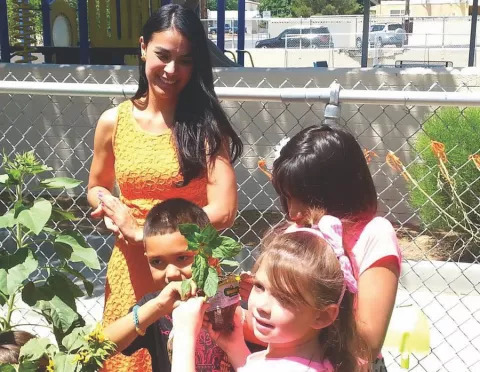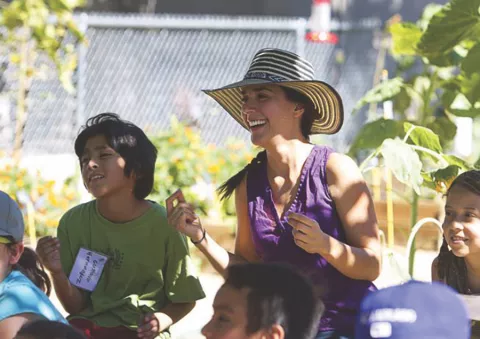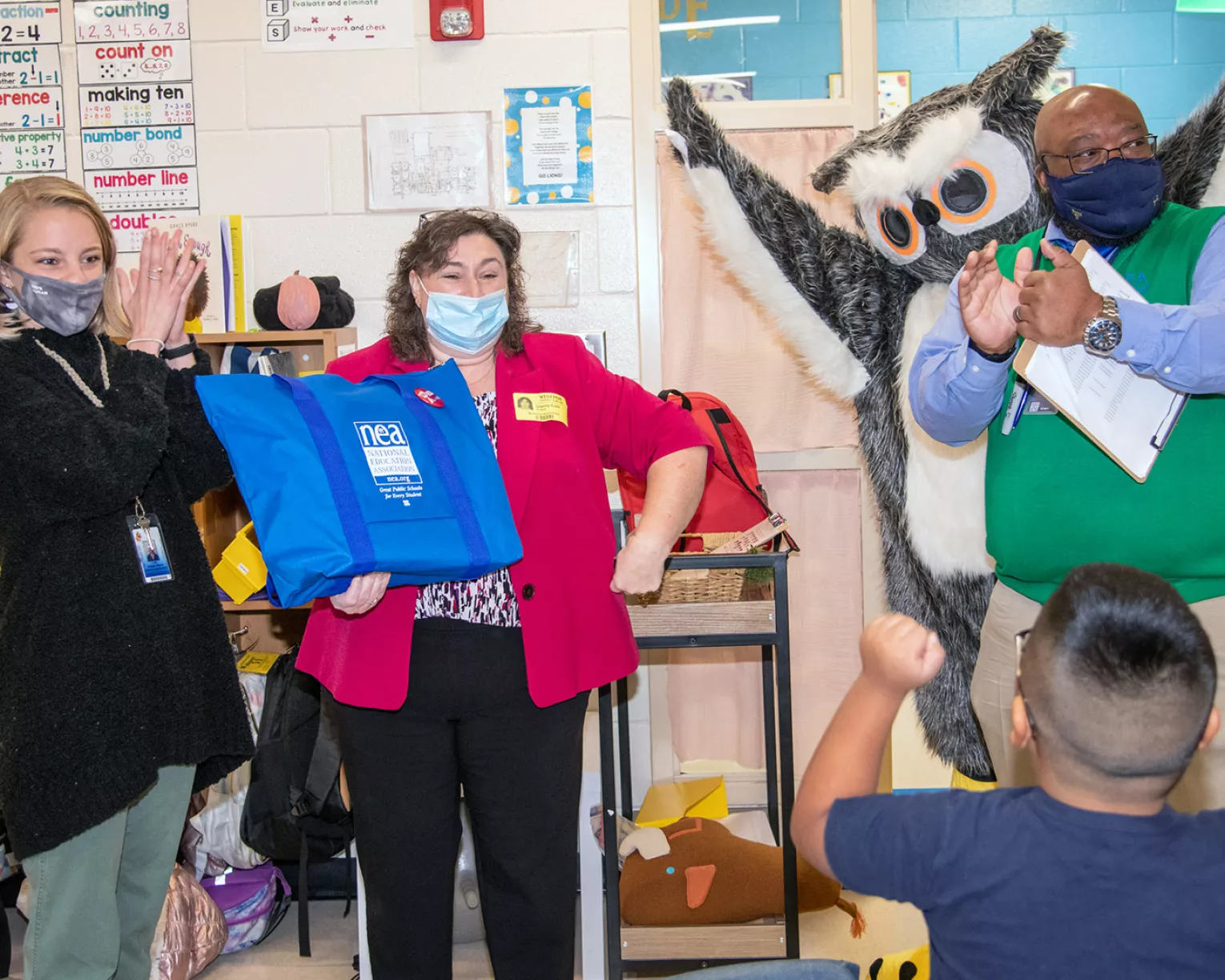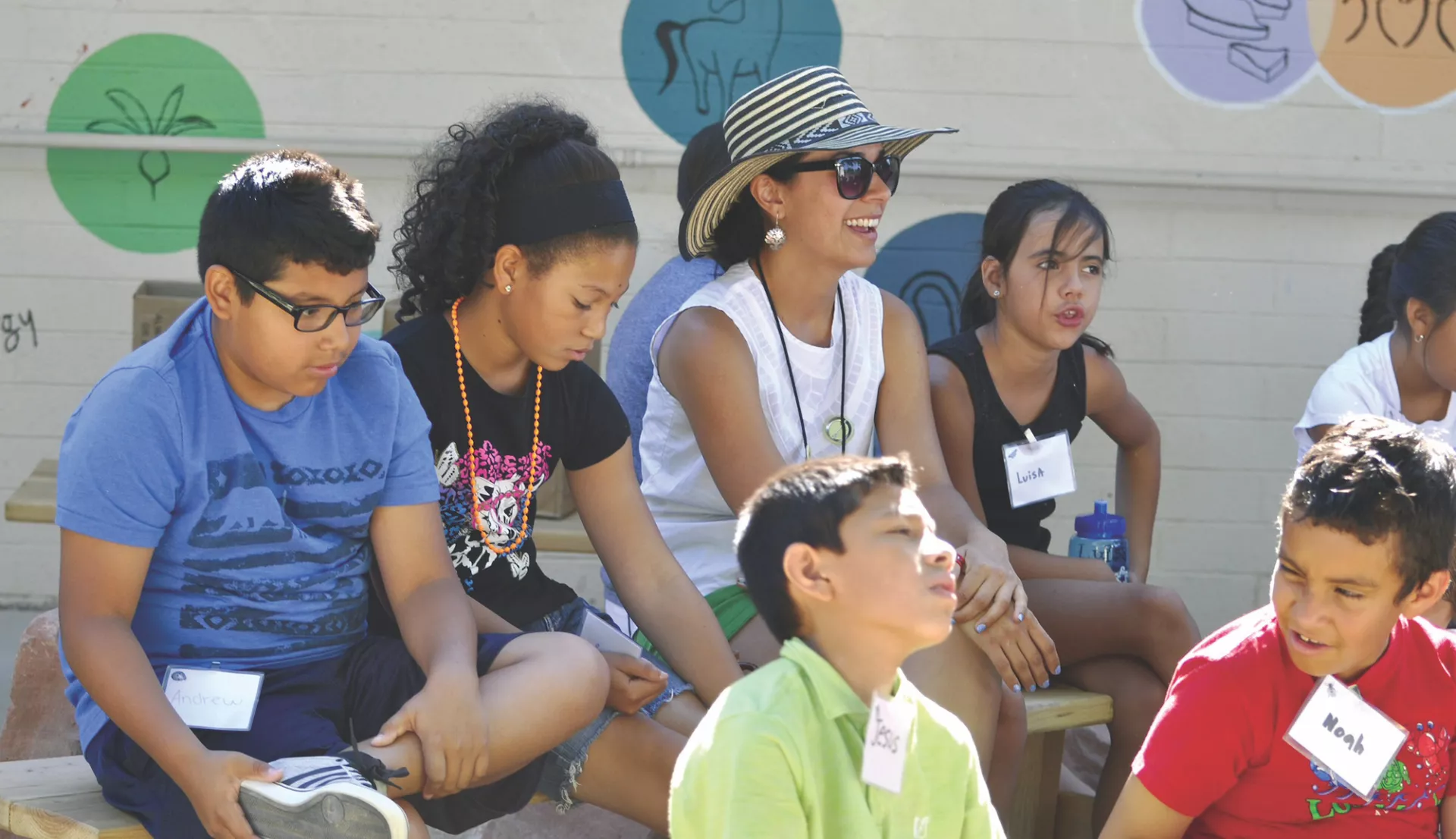
Educating through the COVID-19 pandemic has been difficult, but one thing I have learned is that family partnerships are indispensable to a thriving community. The resilience that we’ve built during the pandemic through partnering with families was only possible through our interdependence in school.
I titled my Teacher of the Year platform “A Joyous and Just Education.” By joyous, I mean that all students have a deep sense of belonging in their schools, because those schools know who they are, and we uplift their strengths, their culture, their linguistic gifts. By just, I mean that we are identifying inequities and barriers to access that and are working creatively to make space more accessible and better places to learn.
This is especially important for English language learners (ELLs), who learn and think differently. Establishing a strong partnership is a win for students, families, and teachers alike. We can all benefit from the rich cultural and linguistic experiences these families bring to the school community.
Sometimes barriers can get in the way of family engagement. That can leave families’ expertise and contributions unrecognized and untapped by schools. So how can you tap into this rich resource, especially when it comes to conversations about special education? Here are some things to keep in mind about culture, language, and immigration—plus some strategies to help you get started.
Expectations of Schools
How a family participates in a child’s education, including special education services, can depend on what the family understands their role in their child’s education to be. It can also have to do with how the family feels at the school.
For example, in many Latin American countries, public education calls for a family’s participation in terms of providing school uniforms and materials. Families are also expected to prepare children for school by teaching social, behavioral, and emotional life skills. Often, public schools in Latin America do not invite families to teach academics, partner with the teacher, or provide information on the child’s learning like they do in the United States, according to research.
Sometimes barriers can get in the way of family engagement. That can leave families’ expertise and contributions unrecognized and untapped by schools.
As educators, it’s our job to communicate to all families that we want to draw on their valuable assets. Those assets can greatly contribute to their child’s development and learning, especially if a child is struggling in school.
Take, for instance, first-generation immigrants who may not have had access to education past primary school or who may not yet speak fluent or academic English. Those family members may assume they can’t contribute to their child’s academic development. Here again, schools can help them understand the important contributions they are already making and can continue making as experts of their children.
Strategies
- If your school is holding parent-teacher conferences, send home a letter explaining what conferences are and their purpose (some families may think that they or their child did something wrong). Encourage families to prepare questions to ask at the conferences.
- Consider activities that allow families to participate regardless of language, like painting a mural or helping in the school garden.
- Find ways for families to share their perspective on what matters most to them about their child’s education.
- Engage students in creating an artifact (like a drawing or a letter) for their family members using their home language or cultural depictions, telling what they want to share about school
Cultural Perspectives About Disability
Different cultures may have different perceptions, definitions, and expectations about disabilities. Those cultural associations or stigmas can impact how families view their child’s disability. Some families may blame themselves for their children’s disabilities. Others may believe a curse is to blame for the disability, rather than a medical cause. Of course, be careful not to make assumptions about families’ preferences or perspectives based on their culture or language.
As one example of a cultural view, people in many Latin American countries use the term “disabilities” to mean a visible or medical disability. Learning disabilities that are not immediately obvious may not be considered disabilities.

Also, many Latinx families think of kindness, good behavior, a strong work ethic, and collective responsibility to family as “being educated.” So the idea that a child may have a learning disability may conflict with the family’s perception that their child is an active and able part of their community. They may disagree with or feel discouraged by the news of their child’s disability. On the other hand, some of the Native American families I’ve collaborated with have viewed disabilities more holistically. They have shared that their communities tend to focus on supporting the strengths of people with disabilities.
Clearly, different cultures respond differently to the concept of “disabilities.” But no matter the culture, families may also have questions about whether a disability is something the child will “grow out of ” or whether the struggle is actually related to learning English. It’s important to be prepared for these questions with updated information about the child’s evaluation and about instruction and progress in English.
Talk with families to frame the term “disability” by focusing on the child’s strengths and needs. Here are three important messages to communicate:
- A child’s learning or thinking difference is not a deficit.
- The child has many strengths from which to build.
- There are specific supports the child can receive to build on those strengths.
Most families want to make sure their child has access to the supports they need to learn and thrive. When we frame special education supports this way, the conversation shifts from focusing on deficits to finding opportunities for better learning experiences.
Strategies
- To learn more about cultural perspectives on disability, talk with colleagues, like ELL teachers, family liaisons, or interpreters. Other families with experience in special education can also provide insights.
- When you speak with the family, share your insights about the student’s strengths and interests, as well as examples of personal interactions with the student. This will help families understand that you care and that you see the child’s strengths—not only the disability.
- Allow the family to share information about the child’s strengths at home and in the community, especially non-academic strengths. Include the family members’ strengths, too.
- Ensure that families understand the services that their child is receiving or is eligible to receive.
Language
Families of English language learners have a legal right to access school documents and meetings in their home language. That includes special education paperwork and communication. Both oral and written translation of special education information requires expertise in the services and terminology.
Ideally, the translation and interpretation will also take cultural factors and nuances into account, especially given the different cultural perspectives on disability. It also should be provided in a format that is accessible and user-friendly.

After the information is translated, it’s critical that families understand the terms—and the implications of those terms. For example, a translator may use the Spanish term “problema de aprendizaje,” which translates to “learning problem.” This term may not convey to families that this “problem” is a disability that needs to be addressed by special services.
Strategies
- Explain to families that they have a right to access information in their home language. Be clear that you value their language and see it as an asset for their child.
- Learn more about your school’s or district’s translation services to make sure families have full access to information they need to participate meaningfully in this process. For example, the school district may provide a translation hotline. In addition, community members or other parents can be trained as volunteer interpreters. (Students should not serve as interpreters in these situations.)
- If you are working with an interpreter, sit down before family meetings to talk through any areas of concern. Ask about particular issues, cultural factors, or perspectives you should understand.
- If adequate language support is not being provided to families, raise your concern with colleagues or administrators. Look for additional information and resources from ELL/bilingual colleagues, family liaisons, district departments, or your state ELL department.
Immigration Concerns
Some immigrant families may have mixed immigration status, meaning that not all family members are documented U.S. residents or citizens. Family members may feel uneasy about participating in formal school meetings, filling out paperwork, or sharing personal information with the school. Perhaps families are unsure of their rights or those of their children. They could also be concerned about immigration enforcement.
You should approach families with empathy when talking about the complexities that immigrant families face. Take the time to understand a family’s concerns that might come up when discussing services available and legal paperwork. Educators like you can put practices into place that help build a culture of caring and safety at your school.
Strategies
- Communicate clearly with families and colleagues that all students in the United States have a right to a free, appropriate education, regardless of immigration status. The immigration status of a child or family member has no impact on eligibility for special education services.
- Keep in mind that families may be wary of signing documents (related to the special education process or otherwise), especially if they have experience with detention or deportation. By building trust, you should be able to partner with families to obtain services that make a significant difference.
- For similar reasons, families may also be worried about coming to school or sharing personal information. Schools are still considered “sensitive locations” where immigration enforcement should not take place. Students also have certain legal protections regarding personal information and privacy, regardless of immigration status. If families have questions about these topics, direct them to accurate, updated information from administrators or school district personnel.
- Draw on strategies to work around barriers to communication with families. Know that family members who are working and do not have work visas may be more vulnerable at work. This could mean that they are unable to answer their phones during work hours or take time off of work for school meetings.
Partnerships that Promote Growth
For English language learners who learn and think differently— and their families—navigating school can be complex. As an educator, you can draw on a student’s and family’s assets to lay the foundation for genuine, solid partnership. By doing so with an open mind and empathy, you will begin building a trusting relationship that will benefit your students, often in life-changing ways.
Reprinted courtesy of Understood.org. © 2021 Understood for All, Inc. All rights reserved.
_____________________________________________________________________
Strategies for Promoting Good Family and Community Engagement
NEA’s Center for Great Public Schools offers micro-credentials to help you engage parents and communities. Here are just a few of the helpful tips they offer:
-
Save information you collect from each student and their family and use it to tailor culturally responsive practices to that student’s needs.
-
Ask families to identify their preferred communications method and use method to ensure equal access for all families.
-
Conduct home visits to build trusting partnerships with families.
-
Involve students and families in a project that addresses a problem in the school community.
-
Share student progress data with families in multiple ways to ensure it is accessible and understandable.
-
Collaborate with a community partner to design and implement a family-focused event, service, or program.
-
Identify family needs and create are sources guide that addresses those needs.
To learn more and sign up, go to www.nea.org/professional-excellence/professional-learning/ micro-credentials.
Learn More







